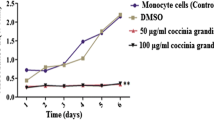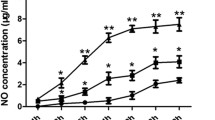Abstract
Betulinic acid (BA), a pentacyclic triterpene isolated fromLycopus lucidus, has been reported to be a selective inducer of apoptosis in various human cancer and shown anti-inflammatory and immunomodulatory properties. We postulated that BA modulates the immunomodulatory properties at least two groups of protein mediators of inflammation, interlukin-1β (IL-1β) and the tumor necrosis factor-a (TNF-α) on the basis of the critical role of the monocytes and tissue macrophages in inflammatory and immune responses. TNF-α and IL-1β were produced by BA in a dose dependent manner at concentration of 0.625 and 10 μg/mL. The production of NO associated withiNOS was inhibited when treated with LPS at the concentration of 2.5 to 20 μg/mL of BA whereas COX-2 expression was decreased at 2.5 to 20 μg/mL. These modulations of inflammatory mediators were examined in LPS-stimulated RAW 264.7 cells and peritoneal macrophages. The morphology of macrophage was also examined and enhanced surface CD 40 molecule was expressed when treated BA at 0.625–5 ¼g/mL with or without LPS. Furthermore, BA (20 μg/mL) enhanced apoptosis by producing DNA ladder in the RAW 264.7 cells. Our results indicated that BA induced activation of macrophage and pro-inflammatory cytokines. This may provide a molecular basis for the ability of BA to mediate macrophage, suppress inflammation, and modulate the immune response.
Similar content being viewed by others
References
Aggarwal, B. B., Schwarz, L., Hogan, M. E., and Rando, R. F., Triple helix forming oligodeoxyribonucleotides targeted to the human tumor necrosis factor (TNR) gene inhibit TNR production and block the TNF-dependent growth of human glioblastoma tumor cells.Cancer research, 56, 5156–5164 (1996).
Ahmad, N., Chen, L. C., Gordon, M. A., Laskin, J. D., and Laskin, D. L. Regulation of cycloxygenase-2 by nitric oxide in activated hepatic macrophages during acute endotoxemia.J. Leukocyte Biology, 71, 1005–1011 (2002).
Amort, C. H., Scott, K. A., Moore, R. J., Hewer, A., Phillips, D. H., Parker, P., Balkwill, F. R., and Owens, D. M., Tumor necrosis factor-alpha mediates tumor promotio.via a PKC alpha- and AP-1-dependent pathway.Oncogene, 21, 4728–4738 (2002).
Bringmann, G., Saeb, W., Assi, L. A., Francois, G., Sankara Narayanan, A. S., Peters, K., and Peters, E. M., Betulinic acid: isolation from Triphyophyllum peltatum and Ancistrocladus heyneanus, antimalarial activity, and crystal structure of the benzyl ester.Planta Medica, 63, 255–257 (1997).
Charles, A. J., Paul, T., and Mark, W., Immunobiology, The immune system in health and disease, Current Biology Publications, London, UK, pp. 300, 1999.
Cho, J. Y., Park, J., Yoo, E. S., Baik, K. U., and Park, M. H., Effect of ginseng saponin on tumor necrosis factor-α production and T cell proliferation.Yakhak Hoeji, 43, 296–301 (1998).
Choi, Y. E., Ahn, H., and Ryu, J., Polyacetylenes fro.Angelica gigas and their inhibitory activity on nitric oxide synthesis in activated macrophages.Biological and Pharmaceutical Bulletin, 23, 884–886 (2000).
Djeu, J. Y., Blanchard, D. K., Richards, A. L., and Friedman, H., Tumor necrosis factor induction b.Candida albicans from human natural killer cells and monocytes.J. Immunology, 141, 4047–4052 (1988).
Fujioka, T., Kashiwada, Y., Kilkuskie, R. E., Cosentino, L. M., Ballas, L. M., Jiang, J. B., Janzen, W. P., Chen, I. S., and Lee, K. H., Anti-AIDS agents, 11. Betulinic acid and platanic acid as anti-HIV principles from Syzigium claviflorum, and the anti-HIV activity of structurally related triterpenoids.J. Natural Products, 57, 243–247 (1994).
Fulda, S., Friesen, C., Los, M., Scaffidi, C., Mier, W., Benedict, M., Nunez, G., Krammer, P. H., Peter, M. E., and Debatin, K. M., Betulinic acid triggers CD95 (APO-1/Fas)- and p53-independent apoptosi.via activation of caspases in neuroectodermal tumors.Cancer Research, 57, 4956–4964 (1997).
Fulda, S., Scaffidi, C., Susin, S. A., Krammer, P. H., Kroemer, G., Peter, M. E., and Debatin, K. M., Activation of mitochondria and release of mitochondrial apoptogenic factors by betulinic acid.J. Biological Chemistry, 18, 33942–33948 (1998).
Giri, D. K. and Aggarwal, B. B., Constitutive activation of NF-kappa B causes resistance to apoptosis in human cutaneous T cell lymphoma HuT-78 cells. Autocrine role of tumor necrosis factor and reactive oxygen intermediates.J. Biological Chemistry, 273, 14008–14014 (1998).
Hafner, M., Orosz, P., Kruger, A., and Mannel, D. N., TNF promotes metastasis by impairing natural killer cell activity.International J. Cancer, 66, 388–392 (1996).
Hashimoto, F., Kashiwada, Y., Cosentin, L. M., Chen, C. H., Garrett, P.E., and Lee K.H.Bioorganic & Medicinal Chemistry, 5, 2133–2143 (1997).
Hehlgans, T., Stoelcker, B., Stopfer, P., Muller, P., Cernaianu, G., Guba, M., Steinbauer, M., Nedospasov, S. A., Pfeffer, K. and Mannel, D. N., Lymphotoxin-beta receptor immune interaction promotes tumor growth by inducing angiogenesis.Cancer Research, 62, 4034–4040 (2002).
Komori, A., Yatsunami, J., Suganuma, M., Okabe, S., Abe, S., Sakai, A., Sasaki, K., and Fujiki, H., Tumor necrosis factor acts as a tumor promoter in BALB/3T3cell transformation.Cancer Research, 53, 1982–1985 (1993).
Kronckes, K. D., Fehsel, K., and Kolb-Bachofen, V., Nitric oxide: cytotoxicity versus cytoprotection: how, why, when, and where.Nitric Oxide, 1, 107–120 (1997).
Krutmann, J. and Elmets, C. A., Recent studies on mechanisms in photoimmunology.Photochemistry and Photobiology, 48, 787–798 (1988).
Moncada, S., Palmer, R. M., and Higgs, E. A., Nitric oxide: physiology, pathophysiology and pharmacology.Pharmacological Reviews, 43, 109–142 (1991).
Moore, R. J., Owens, D. M., Stamp, G., Arnott, C., Burke, F., East, N., Holdsworth, H., Turner, L., Rollins, B., Pasparakis, M., Kollias, G., and Balkwill R Mice deficient in tumor necrosis factor-alpha are resistant to skin carcinogenesis.Nature medicine, 5, 828–831 (1999).
Mukherjee, P. K., Saha, K., Das, J., Pal, M., and Saha, B. P., Studies on the anti-inflammatory activity of rhizomes o.Nelumbo nucifera.Planta Medica, 63, 367–369 (1997).
Noel, R. R., Everly, C. M., John, L. R., Herman, P., and Gerald, M. P., The Manual of Clinical Laboratory Immunology, Herman Rriedman, U.S.A., pp. 233–235 (1991).
Orosz, P., Echtenacher, B., Ralk, W., Ruschoff, J., Weber, D., and Mannel, D. N., Enhancement of experimental metastasis by tumor necrosis factor.J. Experimental Medicine, 177, 1391–1398 (1993).
Orosz, P., Kruger, A., Hubbe, M., Ruschoff, J., Von Hoegen, P., and Mannel, D. N., Promotion of experimental liver metastasis by tumor necrosis factor.International J. Cancer, 60, 867–871 (1995).
Otto, J. C., DeWitt, D. L., and Smith, W. L.,N-Glycosylation of prostaglandin endoperoxide synthase-1 and 2 and their orientations in the endoplasmic reticulum.J. Biological Chemistry, 68, 18234–18242 (1993).
Pisha, E., Chai, H., Lee, I. S., Chagwedera, T. E., Famsworth, N. R., Cordell, G. A., Beecher, C. W., Fong, H. H., Kinghorn, A. D., Brown, D. M., Wani, M. C., Wall, M. E., Hieken, T. J., Das Gupta, T K., and Pezzuto, J. M., Discovery of betulinic acid as a selective inhibitor of human melanoma that functions by induction of apoptosis.Nature Medicine, 1, 1046–1051 (1995).
Roberts, L. K., Smith, D. R., Seilstad, K. H., and Jun, B. D., Photoimmunology: the mechanisms involved in immune modulation by UV radiation.J. Photochemistry Photobiology, 2, 149–177 (1988).
Redo, M. C., Giner, R. M., Manez, S., Gueho, J., Julien, H. R., Hostettmann, K., and Rios, J. L., Investigations on the steroidal anti-inflammatory activity of triterpenoids fro.Diospyros leucomelas.Planta Medica, 81, 9–14 (1995).
Schmidt, M. L., Kuzmanoff, K. L., Ling-lndeck, L., and Pezzuto, J. M., Betulinic acid induces apoptosis in human neuroblastoma cell lines.European J. Cancer, 33, 2007–2010 (1997).
Seiber, K., Zhang, Y., Leahy, K., Hauser, S., Masferrer, J., Perkins, W., Lee, L., and Isakson, P., Pharmacological and biochemical demonstration of the role of cycloxygenase-2 in inflammation and pain.Proceedings of the National Academy of Sciences of the United States of America, 91, 12013–12017 (1994).
Stuehr, D. J. and Nathan, C. R., Nitric oxide, a macrophage product responsible for cytostasis and respiratory inhibition in tumor target cells.J. Experimental Medicine, 169, 1543–1555 (1989).
Sueoka, E., Sueoka, N., Kai, Y., Okabe, S., Suganuma, M., Kanematsu, K., Yamamoto, T., and Rujiki, H., Anticancer activity of morphine and its synthetic derivative, KT-90, mediated through apoptosis and inhibition of NF-kappa B activation.Biochemical and Biophysical Research Communications, 252, 566–570 (1998).
Suganuma, M., Okabe, S., Sueoka, E., lida, N., Komori, A., Kim, S. J., and Fujiki, H., A new process of cancer prevention mediated through inhibition of tumor necrosis factor alpha expression.Cancer Research, 56, 3711–3715 (1996).
Suganuma, M., Okabe, S., Marino, M. W., Sakai, A., Sueoka, E., and Fujiki, H., Essential role of tumor necrosis factor alpha (TNF-alpha) in tumor promotion as revealed by TNF- alpha-deficient mice.Cancer Research, 59, 4516–4518 (1999).
Suganuma, M., Okabe, S., Kurusu, Iida M., Ohshima, S., Sacki, Y., Kishimoto, T., and Fujiki, H., Discrete roles of cytokines, TNF-a, IL-1, IL-6 in tumor promotion and cell transformation.International J. Oncology, 20, 131–136 (2002).
Yasukawa, K., Takido, M., Matsumoto, T., Takeuchi, M., and Nakagawa, S., Sterol and triterpene derivatives from plants inhibit the effects of a tumor promoter, and sitosterol and betulinic acid inhibit tumor formation in mouse skin two-stage carcinogenesis.Oncology, 48, 72–76 (1991).
Author information
Authors and Affiliations
Corresponding author
Rights and permissions
About this article
Cite this article
Yun, Y., Han, S., Park, E. et al. Immunomodulatory activity of betulinic acid by producing pro-inflammatory cytokines and activation of macrophages. Arch Pharm Res 26, 1087–1095 (2003). https://doi.org/10.1007/BF02994763
Received:
Issue Date:
DOI: https://doi.org/10.1007/BF02994763




